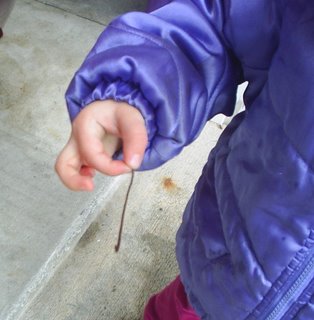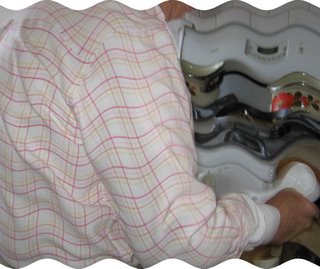 We just returned from a walk in the misty fall air. Naturally the little one was attracted to those 2-inch long skinny things that wiggled across the concrete. Worms! It rained a lot last night and this morning, so worms appeared everywhere. In the spring, it's a great time for catching fishing bait, especially where someone, years ago, buried very large Canadian nightcrawlers.
We just returned from a walk in the misty fall air. Naturally the little one was attracted to those 2-inch long skinny things that wiggled across the concrete. Worms! It rained a lot last night and this morning, so worms appeared everywhere. In the spring, it's a great time for catching fishing bait, especially where someone, years ago, buried very large Canadian nightcrawlers.My kids were introduced to the sport of nightcrawler hunting by their uncle over 30 years ago. It's in a rural area and rain was falling, so he told my husband to bring the kids late that evening to a nearby small town with lots of sidewalks, and where someone had planted night crawlers many years before. The kids returned very excited and laughing a lot, as they told everyone who would listen how much fun they had.
They described how their flashlights were used to find these giant worms that can be as big as small snakes. The kids said they had to be very fast to grab worms found in the grass. A nightcrawler places only part of its body outside its mounded hole, and very quickly withdraws if you shine a flashlight beam on it.
My husband said he also fully enjoyed the hunting of these very large, fast, and wriggly creatures, especially hearing the triumphal shouts of a child catching one, or the groans of defeat in losing one. (The rule was that you weren't supposed to catch only pieces of worms!)
My folks had a big yard and they had planted nightcrawlers a few years before. I participated in the next outing, just before the time when the yard was invaded by moles and other worm-eating critters who began to live sumptuously. That night the kids competed to catch the most worms. In about an hour, the kids had caught almost a gallon of solid worms!
We put some of them back in the grass, but my mother took a lot and refrigerated them in coffee cans filled with dirt until she and my dad went on their weekly fishing outing. [BTW, you need to poke small holes in the lids for air to penetrate inside; the fairly wet dirt also needs to be changed every three weeks or so.]









1 comment:
Heh. Make sure when you hit them with the light, you don't hit them with the center of the light, the outside of the corona only.
When you pull them, don't jerk them (or you get half a worm) you pull them slow and smooth. :)
Post a Comment